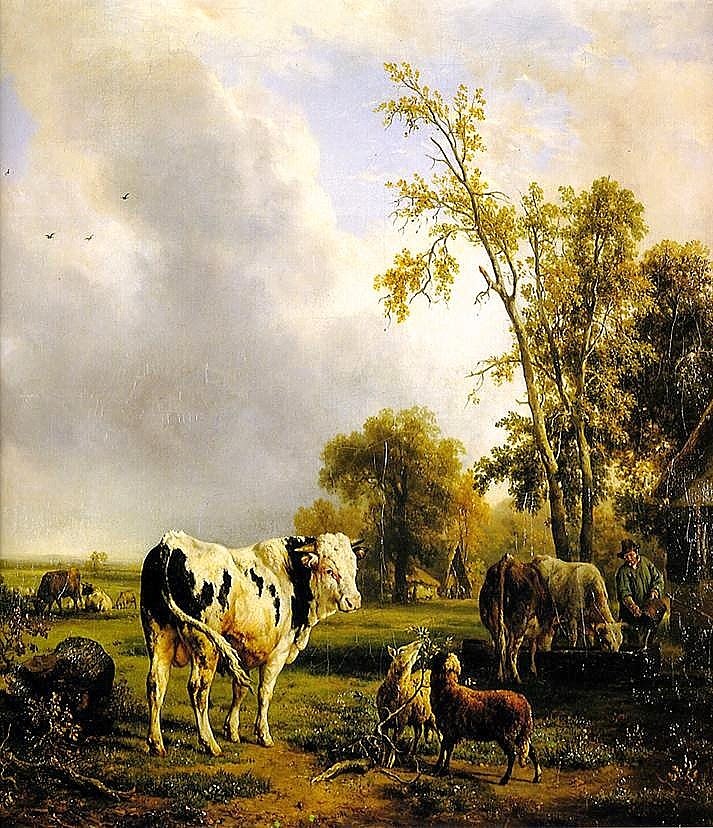 |
| Odette, a Maltese on an Embroidered Cushion, Jacques Raymond Brascassat |
 |
| Jacques Raymond Brascassat Self-portrait |
Some of the most beloved portraits we have today do not involve human subjects. Human portraits are considered valuable only if the subject is famous, or the artist is famous, or if there is a historic factor involved. Otherwise, once those who remember the individual have all died, the portrait becomes "just another pretty face"...or not, depending on the face. There is too much sameness to most portraiture for the painting to be considered outstanding art in its own right. Of course, exceptions abound, Sargent's Madame X, for instance, Gainsborough's Blue Boy and others come to mind but such paintings are rare. However, portraits of animals are often revered long, long after the portrait's subject has passed away. The early 19th-century French artist, Jacques Raymond Brascassat, painted prime examples of what I mean. In effect, the portrait of a once beloved pet remains a pet, with the added advantage of no longer needing to be fed, bathed, and allowed access to the outdoors to "do its business." (Don't you just love euphemisms?)
 |
| A Bull in a Landscape, Jacques Brascassat |
As his self-portrait (above) indicates, Jacques Brascassat could paint people as well as the next thousand or so French portrait painters of his time (he was born in 1804). On the other hand, he painted cows, cats, chickens, and dogs considerably better than most. As his A Bull in a Landscape (above, suggests, he did okay painting bulls too). Any kid at a county fair would be proud to parade such a magnificent, noble-looking animal. (I'm about to have a Big Mac attack.) Thanks to Brascassat, we can voice our appreciation of such a painting long after it's subject has had his fun in the sun and succumbed to the bun.
 |
| A View of Bordeaux, 1822, Jacques Brascassat--not a grapevine in sight. |
Brascassat, as his name suggests, was French, a native of the Bordeaux region, which is about as French as one can be. He didn't start out to be a bull-painter but began by painting unexceptional landscapes. He studied in Paris, probably at the Ecole des Beaux Arts, judging by the fact he won the 1825 Prix de Rome allowing him a free trip to the Italian art mecca and what came to be eight years studying antiquities and how to paint them while rendering quite a number of highly prized (and praised) Italian landscape. Italian landscapes were seen as more romantic than French landscape for some stupid reason. Who knows why.
 |
| A Bull Fight, 1855, Jacques Bascassat--where's the matador? |
 |
White Bull and Other Animal,
Jacques Brascassat |
When Brascassat returned home in 1835 he displayed his landscapes in Paris and was probably rather cha-grined to find that what appealed most to buyers were the
animals he'd pretty much randomly included in his work. So, in seeing a golden opportunity, he seized it; enlarging the importance (and size) of his landscape animals to the point the landscape part became a largely inconsequential background to the real action, such as his most famous work,
The Bull Fight (above)
from 1837. His
Cows Attacked by Wolves (below) from 1845, is just as dramatic. The French love their cows, apparently more than Italian land-scapes. In any case, Brascassat be-came extremely good at what he did not to mention rich and famous, the most important animal painter in mid-century France.
 |
| Cows Attacked by Wolves, 1845, Jacques Brascassat |
 |
Greyhound Resting in a Chair, 1836,
Jacques Brascassat |
But Brascassat's talent for pain-ting animals did not begin or end with livestock. He also became popular for painting pets, which was almost as important an art specialty then as it is now (lots more people have pets now than then). His sweetly elegant
Mal-tese, Odetta (top) and his sleek, slender
Greyhound Resting in a Chair,painted in 1836, shortly af-ter his return to Paris
, demon-strates the appeal of his work to both French genders. He even managed to combine one of his canine subjects with the French admiration of a well-rendered still-life as seen in his
Spaniel with a Still-life of Dead Game, from 1837--perfect for the 19th-century French man-cave.
 |
| Spaniel with a Still Life of Dead Game, 1837, Jacques Brascassat |
 |
| Giraffe Crossing, 1827, Jacques Brascassat |
Though no where nearly as pop-ular as dogs, Brascassat also knew how to paint cute kitty cats as well (bottom), not to mention giraffes (as seen in his
Giraffe Crossing, (left) which is an actual depiction of "Zarafa," the famous giraffe, presumably painted during her journey from Marseilles to Paris in that year. His repertoire also included sheep and goats with the occasional shepherd and sometimes a pretty mademoiselle for human interest. Jacques Ray-mond Brascassat died relatively young, in 1867 at the age of sixty-three, before having to deal with the revolutionary changes coming to French art with the advent of Impressionisms. Portraits of him, by himself and others, are about as vacant looking as portraits are allowed to be. Even the museums which own them probably don't display them much. However, his animal portraits have a timeless charm that few would find bland or boring. And, they don't bark when someone comes to visit.
 |
| A Small Family, Jacques Brascassat. Best of all, his sweet, playful little kittens never become Brascassat CATS. |











Giraffe Crossing (1827) is actually a depiction of "Zarafa" the famous giraffe -- presumably during her journey from Marseilles to Paris in that year.
ReplyDeleteThanks for your comment. I have adjusted the text.
ReplyDeleteYou're very welcome.
Delete